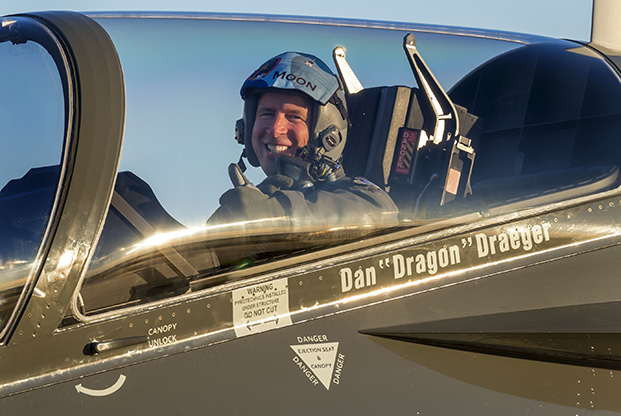Maj. Gen. Patrick Doherty, 19th Air Force commander, gets ready for a T-X familiarization sortie at the Boeing facility in St. Louis Nov. 27, 2018. Air Force photo.
SAN ANTONIO—The Air Force needs to overhaul its pilot training program so it can get ahead of a potentially crippling pilot shortage and better prepare the pilots it does have for future threats, a key officer overseeing pilot training said Thursday.
The Air Force is short thousands of pilots and has turned to 19th Air Force to increase its throughput, but at the same time the Pentagon’s National Defense Strategy calls for preparing to meet great power competition. This strategy requires the Air Force to train pilots who can face near-peer threats, and have more capability to make decisions on their own, 19th Air Force Commander Maj. Gen. Patrick Doherty said.
“The first requirement is: We’ve got to produce better aviators in the future,” Doherty said at the Military Flying Training USA 2018 conference here. “Quality has got to come higher, they’re going to need to be a different warrior in the future. One that works autonomously on their own, solving their own problems, and not going through six levels of ‘mother may I?’ to make a simple, tactical level decision.”
The Air Force needs a “sense of urgency to get its competitive spirit back” and counter the strides countries like China and Russia have made. It needs to change things “radically” to be prepared for a very different threat from the one encountered during the last 18 years of war in permissive environments, he said.
To get at this, 19th Air Force has made some changes in how it trains pilots and is eagerly awaiting the next generation trainer to improve the quality of training. The Air Force relies on the T-6 and T-38—which was designed in 1955, and is a “dinosaur”—to produce pilots who are going on to fly advanced aircraft such as the F-35. Doherty flew in the T-X on Nov. 27, and said it has “incredible potential to radically change” how pilots are trained. However, the T-X is not slated to arrive at its first base until 2023 and that is still too slow, he said.
“We need that T-X like, yesterday,” he said. “We need it right now. … The timeline is not acceptable for what the Air Force needs.”
In the near term, 19th Air Force is moving forward on the Pilot Training Next program that began in Austin. The first iteration of the program started with 20 students going through a condensed T-6 syllabus —four months instead of the typical six—using virtual reality systems to learn to fly the aircraft. Of that group, 13 graduated and six became fighter and attack aircraft qualified, Doherty said. All of them met or surpassed the skills of regular undergraduate pilot training graduates, he said. The lowest rated of those who qualified is now “absolutely crushing” defensive basic fighter maneuvers, which “shows you the acceleration we were able to achieve,” he said.
The Pilot Training Next program will begin its second iteration in January. There is a similar program underway for maintenance training at Sheppard AFB, Texas, and those classes eventually will be combined to better keep track of the lessons learned, he said.
